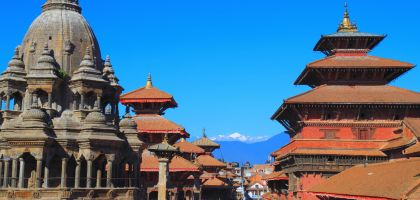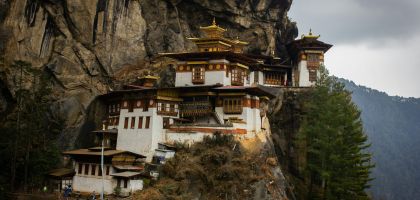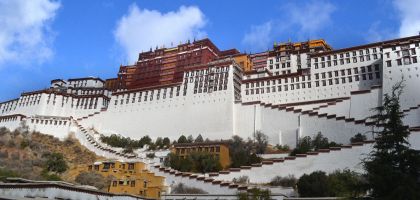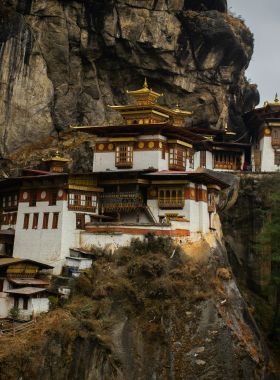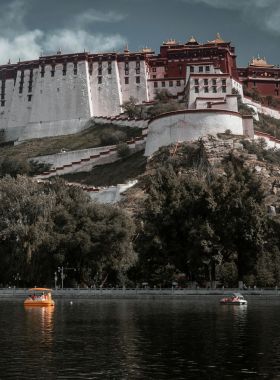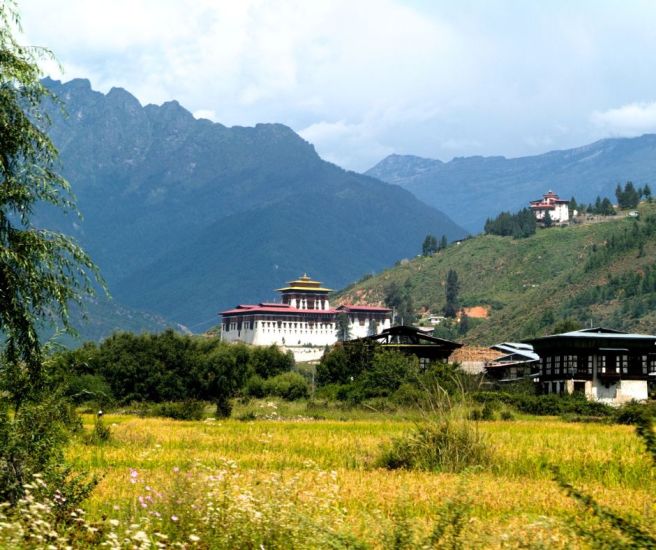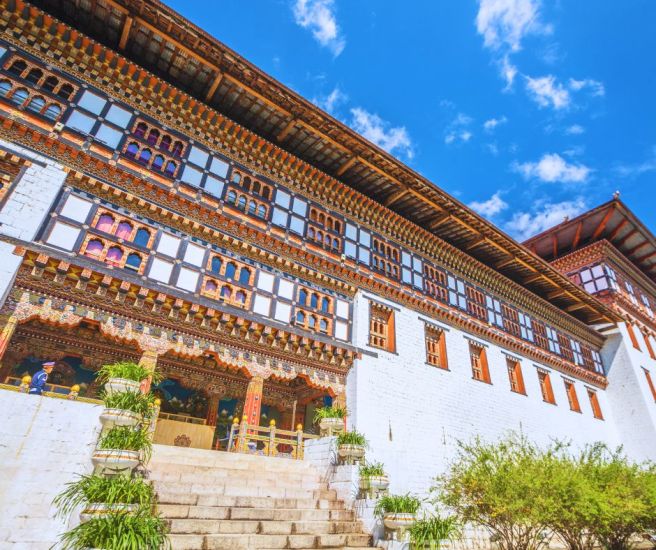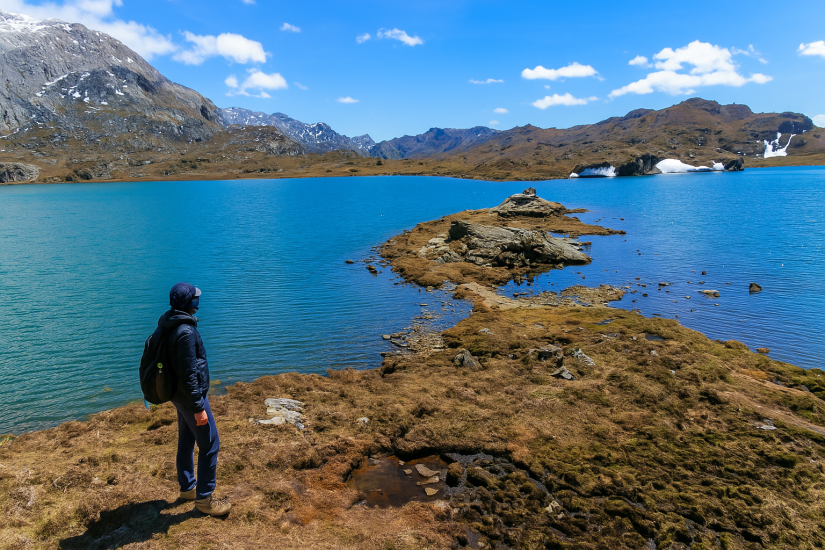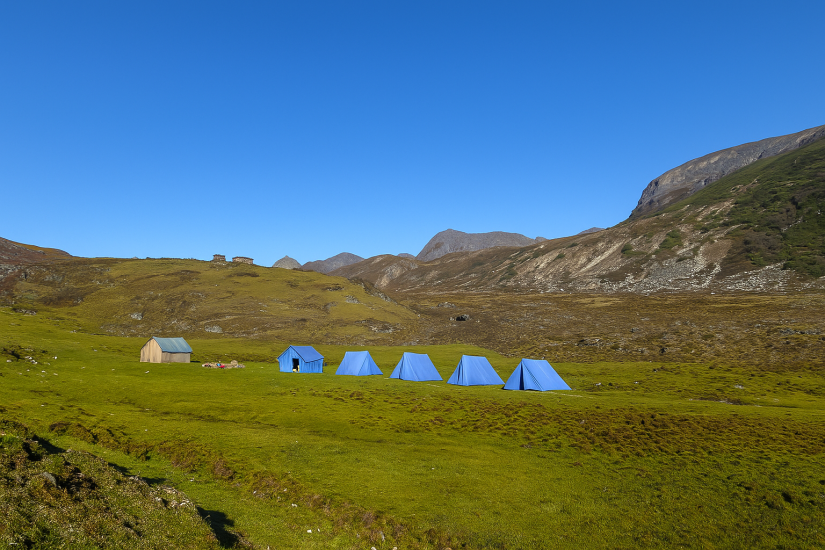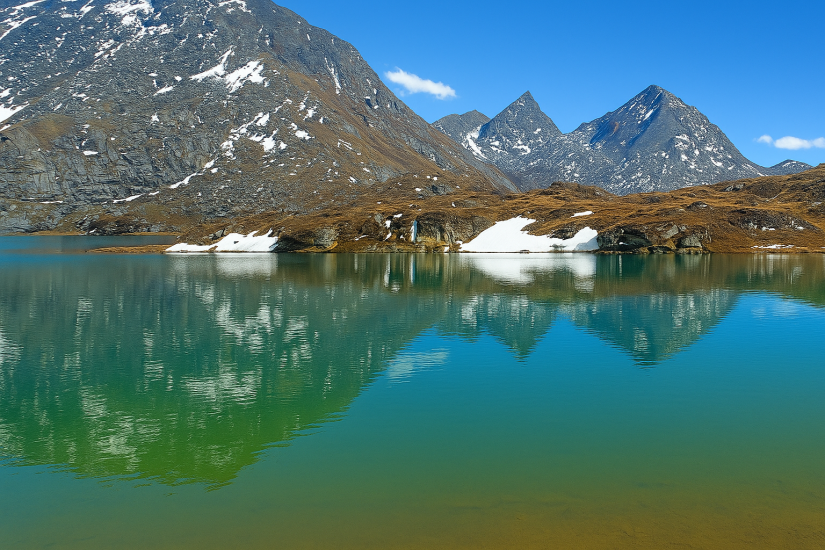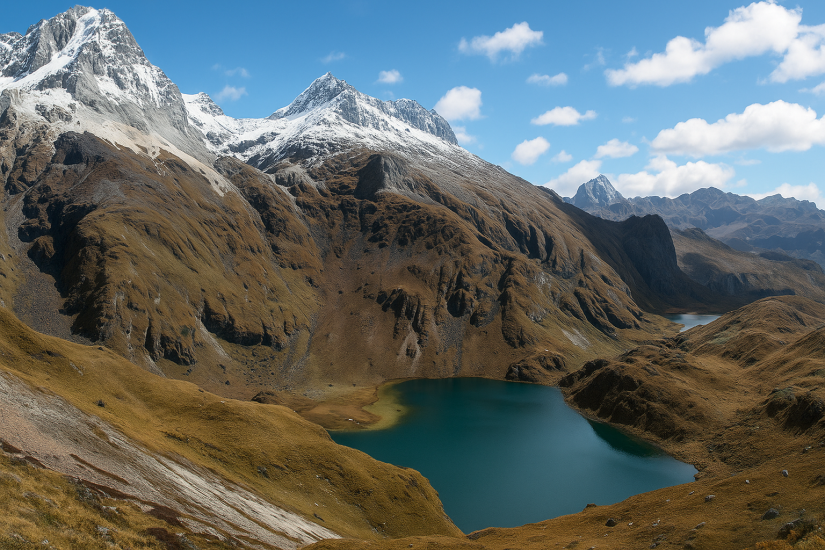Dagala Thousand Lakes Trek
12 Days / Bhutan
Activity
Difficulty Level
Destinations
Trip Start / End
Accommodation
Travel Style
Best time to travel
Personalized Travel Advice

Dev Raj Nepal
+977 9851096523
Detailed Itinerary
01
DAY
01
Your journey begins with a scenic flight into Paro, offering breathtaking views of the world’s tallest mountain on clear days. As you descend into the lush Paro valley, a representative will meet you at the airport and escort you to your hotel. Rest and relax for the evening.
Arrival in Paro
Your journey begins with a scenic flight into Paro, offering breathtaking views of the world’s tallest mountain on clear days. As you descend into the lush Paro valley, a representative will meet you at the airport and escort you to your hotel. Rest and relax for the evening.
02
DAY
02
Start your day with a visit to the National Museum, a premier museum in Asia, followed by the impressive Rinpung Dzong, also known as the “fortress of the heap of jewels.” Continue to Kichu Lhakhang, one of Bhutan’s oldest temples, built in 659 AD. A scenic drive will take you to Drugyel Dzong, a ruined fortress offering a stunning view of Mount Jomolhari (7329m) on clear days. On the way back, stop at a traditional Bhutanese farmhouse for a peaceful walk around the property.
Paro Exploration
Start your day with a visit to the National Museum, a premier museum in Asia, followed by the impressive Rinpung Dzong, also known as the “fortress of the heap of jewels.” Continue to Kichu Lhakhang, one of Bhutan’s oldest temples, built in 659 AD. A scenic drive will take you to Drugyel Dzong, a ruined fortress offering a stunning view of Mount Jomolhari (7329m) on clear days. On the way back, stop at a traditional Bhutanese farmhouse for a peaceful walk around the property.
03
DAY
03
Travel from Paro to Thimphu, following the Pachu River downstream and then up the Wangchu River. The drive will take us around 1.5 hours to reach Thimphu. On the way to Thimphu, stop at Tachogang Lhakhang Bridge, a 15th-century iron suspension bridge adorned with colorful prayer flags. Built by the famous Nyingma tantric master Tangtong Gyalpo, it offers a unique glimpse into Bhutanese history and traditional bridge construction.
Continue the scenic drive to Thimphu, Bhutan’s charming capital, where tradition meets modernity. Once in Thimphu, visit Tashichho Dzong, a beautiful fortress-monastery that serves as the administrative and religious center of Bhutan. After your sightseeing, check in to your hotel for a restful night. Overnight in Thimphu.
Paro to Thimphu
Travel from Paro to Thimphu, following the Pachu River downstream and then up the Wangchu River. The drive will take us around 1.5 hours to reach Thimphu. On the way to Thimphu, stop at Tachogang Lhakhang Bridge, a 15th-century iron suspension bridge adorned with colorful prayer flags. Built by the famous Nyingma tantric master Tangtong Gyalpo, it offers a unique glimpse into Bhutanese history and traditional bridge construction.
Continue the scenic drive to Thimphu, Bhutan’s charming capital, where tradition meets modernity. Once in Thimphu, visit Tashichho Dzong, a beautiful fortress-monastery that serves as the administrative and religious center of Bhutan. After your sightseeing, check in to your hotel for a restful night. Overnight in Thimphu.
04
DAY
04
Today, we begin our exploration of Thimphu with a visit to Buddha Dordenma, an enormous golden statue seated atop a hill overlooking the valley. Standing at 51 meters, this majestic statue is one of the largest Buddha statues in the world and houses thousands of smaller Buddha statues inside. The site offers panoramic views of Thimphu, making it a perfect start to the day.
Next, we visit the Memorial Chorten, a sacred stupa built in honor of Bhutan’s third king, Jigme Dorji Wangchuck. Locals circumambulate the chorten, spinning prayer wheels and offering prayers, creating a deeply spiritual atmosphere. Afterward, we proceed to the National Institute for Zorig Chusum, commonly known as the School of Traditional Arts, where students meticulously practice Bhutan’s 13 traditional arts, including painting, wood carving, and embroidery.
From there, we explore the Folk Heritage Museum, housed in a traditional Bhutanese farmhouse. This living museum offers an immersive experience into rural Bhutanese life, displaying household artifacts, farming tools, and an authentic setting that showcases how Bhutanese families have lived for centuries.
To conclude our day, we visit Changangkha Lhakhang, one of the oldest temples in Thimphu, perched on a ridge overlooking the city. This temple is a spiritual haven for Bhutanese parents who bring their newborns for blessings, and it offers stunning views of the valley below.
Thimphu Exploration
Today, we begin our exploration of Thimphu with a visit to Buddha Dordenma, an enormous golden statue seated atop a hill overlooking the valley. Standing at 51 meters, this majestic statue is one of the largest Buddha statues in the world and houses thousands of smaller Buddha statues inside. The site offers panoramic views of Thimphu, making it a perfect start to the day.
Next, we visit the Memorial Chorten, a sacred stupa built in honor of Bhutan’s third king, Jigme Dorji Wangchuck. Locals circumambulate the chorten, spinning prayer wheels and offering prayers, creating a deeply spiritual atmosphere. Afterward, we proceed to the National Institute for Zorig Chusum, commonly known as the School of Traditional Arts, where students meticulously practice Bhutan’s 13 traditional arts, including painting, wood carving, and embroidery.
From there, we explore the Folk Heritage Museum, housed in a traditional Bhutanese farmhouse. This living museum offers an immersive experience into rural Bhutanese life, displaying household artifacts, farming tools, and an authentic setting that showcases how Bhutanese families have lived for centuries.
To conclude our day, we visit Changangkha Lhakhang, one of the oldest temples in Thimphu, perched on a ridge overlooking the city. This temple is a spiritual haven for Bhutanese parents who bring their newborns for blessings, and it offers stunning views of the valley below.
05
DAY
05
After a 45-minute drive, begin your trek through terraced fields and coniferous forests. Hike for about four hours until you reach the camp near the Genekha School.
Thimphu to Genekha
After a 45-minute drive, begin your trek through terraced fields and coniferous forests. Hike for about four hours until you reach the camp near the Genekha School.
06
DAY
06
You’ll start the day with a 45-minute drive to the charming Genekha Village, the starting point of your trek. Known for its matsutake and chanterelle mushrooms, this village offers a unique glimpse into local life. Your journey will take you along mule paths, through terraced fields, and into coniferous forests rich with alpine flora and teeming with birds. After descending to the river, you’ll embark on a gradual uphill climb for two hours, reaching a vast rock platform at 3,350m, where you’ll be rewarded with stunning views of the valley. Another two hours of trekking will bring you to your campsite at Gur, surrounded by an abundance of wildflowers.
Genekha to Gur
You’ll start the day with a 45-minute drive to the charming Genekha Village, the starting point of your trek. Known for its matsutake and chanterelle mushrooms, this village offers a unique glimpse into local life. Your journey will take you along mule paths, through terraced fields, and into coniferous forests rich with alpine flora and teeming with birds. After descending to the river, you’ll embark on a gradual uphill climb for two hours, reaching a vast rock platform at 3,350m, where you’ll be rewarded with stunning views of the valley. Another two hours of trekking will bring you to your campsite at Gur, surrounded by an abundance of wildflowers.
07
DAY
07
Today, we will make a sharp ascent of about 1,220m, and then a110m descent. The trail takes you through rugged mountain vegetation and meadows. The first pass offers spectacular views of Kanchenjunga and other Bhutanese peaks. After descending, continue through meadows and yak herder camps, eventually reaching the Labatama valley, where you will camp beside a tranquil lake.
Gur to Labatama
Today, we will make a sharp ascent of about 1,220m, and then a110m descent. The trail takes you through rugged mountain vegetation and meadows. The first pass offers spectacular views of Kanchenjunga and other Bhutanese peaks. After descending, continue through meadows and yak herder camps, eventually reaching the Labatama valley, where you will camp beside a tranquil lake.
08
DAY
08
Take a well-deserved rest day at the serene Labatama Valley, surrounded by breathtaking mountain vistas and the tranquil beauty of high-altitude lakes. This peaceful day allows you to explore the nearby lakes—Reli Tsho, Hen Tsho, and Jama Tsho—each offering a unique charm and stunning views. The lakes are perfect for a leisurely walk along their shores, or you may choose to relax and enjoy the tranquil atmosphere
Rest Day at Labatama
Take a well-deserved rest day at the serene Labatama Valley, surrounded by breathtaking mountain vistas and the tranquil beauty of high-altitude lakes. This peaceful day allows you to explore the nearby lakes—Reli Tsho, Hen Tsho, and Jama Tsho—each offering a unique charm and stunning views. The lakes are perfect for a leisurely walk along their shores, or you may choose to relax and enjoy the tranquil atmosphere
09
DAY
09
Today, we will trek for a total of 8 km with a 260m ascent and 520m descent. The journey starts by climbing along Dala Tsho and offers magnificent views of Everest, Kanchenjunga, and the Bhutanese Himalayan peaks. Descend to reach Panka, passing yak herder huts and a river along the way.
Labatama to Panka
Today, we will trek for a total of 8 km with a 260m ascent and 520m descent. The journey starts by climbing along Dala Tsho and offers magnificent views of Everest, Kanchenjunga, and the Bhutanese Himalayan peaks. Descend to reach Panka, passing yak herder huts and a river along the way.
10
DAY
10
Today, you’ll cross several stunning passes, each offering more impressive views than the last. Along the trail, you’ll encounter various species of Blue Poppy (in bloom from June to July) and a variety of mountain birds. Enjoy lunch at the junction where one trail leads to Talakha and the other to Wangduephodrang. Afterward, embark on a gradual climb for an hour to reach the final pass, Tale La (4,180m), where you’ll be treated to panoramic views of the Dagala range and Thimphu. The journey continues with a long descent through forests of spruce, birch, juniper, and rhododendrons, leading you to Talakha Goempa (3,080m). The diverse landscapes along the way make this day unforgettable.
Panka to Talakha
Today, you’ll cross several stunning passes, each offering more impressive views than the last. Along the trail, you’ll encounter various species of Blue Poppy (in bloom from June to July) and a variety of mountain birds. Enjoy lunch at the junction where one trail leads to Talakha and the other to Wangduephodrang. Afterward, embark on a gradual climb for an hour to reach the final pass, Tale La (4,180m), where you’ll be treated to panoramic views of the Dagala range and Thimphu. The journey continues with a long descent through forests of spruce, birch, juniper, and rhododendrons, leading you to Talakha Goempa (3,080m). The diverse landscapes along the way make this day unforgettable.
11
DAY
11
Begin your day with a pleasant 2-3-hour downhill hike through apple orchards and mixed vegetation, enjoying the crisp mountain air and scenic surroundings. The descent offers stunning views as you make your way through picturesque landscapes, ultimately reaching the road where your vehicle will be waiting. After the hike, drive back to Paro, with the journey taking approximately 2 hours. Upon arrival, you’ll have time to relax and unwind at your hotel, reflecting on the adventure-filled days you’ve had in Bhutan. This day provides a perfect balance of nature, tranquility, and travel as you head back to the charming town of Paro.
Talakha to Thimphu and Paro
Begin your day with a pleasant 2-3-hour downhill hike through apple orchards and mixed vegetation, enjoying the crisp mountain air and scenic surroundings. The descent offers stunning views as you make your way through picturesque landscapes, ultimately reaching the road where your vehicle will be waiting. After the hike, drive back to Paro, with the journey taking approximately 2 hours. Upon arrival, you’ll have time to relax and unwind at your hotel, reflecting on the adventure-filled days you’ve had in Bhutan. This day provides a perfect balance of nature, tranquility, and travel as you head back to the charming town of Paro.
12
DAY
12
Your guide will escort you to the airport for your departure, marking the end of your journey in Bhutan.
Departure
Your guide will escort you to the airport for your departure, marking the end of your journey in Bhutan.
Includes / Excludes
Inclusions
-
A level accommodation on twin sharing basis while in the cities.
-
All camping gears that includes-2 person sleeping tents with floors and fly sheet, dinning tent, kitchen tent, toilet tents, dining tables, chairs, pillows and mattresses.
-
English speaking Guide.
-
Cook and kitchen aides.
-
All intercity transfers and sightseeing by a private vehicle.
-
Pack animals and animal drivers during trekking
-
All necessary supplies
-
3 meals a day
-
Bhutan visa processing.
-
Sightseeing admission fees.
-
Bhutan visa fee
Exclusions
-
Airfare into and out of Bhutan
-
Travel Insurance and emergency evacuation.
-
Expenses of personal nature like drinks, tip, telephone, laundry etc.
-
Extra expenses due to nature or unforeseen events such as flight cancellation, road blockade, no show etc.
Trip Info
The best time to do the Dagala Lakes Trek is during the Spring (late March to early May) and Sutumn (late September to early November) seasons.
Spring (Late March to Early May)
This period brings vibrant colors as the Blue Poppy, Bhutan’s national flower, blooms along the trail. The landscape bursts into hues of blue and purple, adding an extra touch of beauty to the trek. The weather is pleasantly cool and clear, perfect for trekking. The spring season offers lush greenery, blooming flowers, and clear skies, making for breathtaking views of the alpine scenery and Himalayan peaks.
Autumn (Late September to Early November)
Autumn is one of the most popular times for trekking in Bhutan, and the Dagala Lakes Trek is no exception. The weather is dry, the skies are clear, and the temperatures are ideal for hiking. This season provides exceptional views of the mountains and the lakes. The autumn season features crisp air, golden foliage, and stable weather conditions, ensuring a comfortable and memorable trekking experience.
For this tour, we prioritize both comfort and safety by providing well-maintained vehicles suited to the group size. If the group consists of fewer than 8 participants, we will use a high-roof Toyota HiAce, a spacious and reliable vehicle with ample legroom and luggage space. For groups larger than 8, we will upgrade to a Mini-bus, ensuring everyone has a comfortable and enjoyable journey together.
Our drivers are highly experienced professionals with extensive knowledge of the routes, terrain, and road conditions. They are trained in defensive driving and safety protocols, ensuring a smooth and secure travel experience. With years of experience navigating mountain roads and varying weather conditions, they prioritize passenger safety while maintaining a steady and comfortable ride.
Additionally, our vehicles undergo regular maintenance and safety checks to ensure reliability throughout the journey. Whether winding through mountain passes or traveling along scenic valleys, you can rest assured that your transportation is in capable hands, allowing you to fully enjoy the beauty of the destination without any worries.
Most parts of this trek will take you to the remote regions of Bhutan. Therefore, there is a scarcity of luxurious accommodations. At regional centers and big towns like Paro and Thimphu, we provide high grade hotels that provide comfort and warmth. However, during the trek, the accommodations are primarily in tents, where trekkers camp in designated spots at various points along the trail. These campsites are typically set up in meadows or near small villages, offering trekkers a chance to experience the beauty of the highlands up close. The camps are equipped with basic facilities like sleeping tents and shared dining tents, where meals are served. In some places, trekkers can stay in simple guesthouses or hotels that provide comfort before and after the trek. The accommodations are functional and designed to complement the trekking experience, offering a cozy respite after a long day on the trail.
Food on this typical Bhutan trek is mostly simple but nutritious, designed to provide energy for the long days of trekking. In the villages and towns, meals are typically served at local guesthouses, where you’ll find traditional Bhutanese dishes such as ema datshi (a spicy cheese and chili dish) and phaksha paa (pork with radishes). During the trek, meals are often prepared by the trek crew, including porters and cooks, and served at the campsites. Expect to have a variety of hearty, locally sourced food, such as rice, vegetables, lentils, and noodles. Breakfast may include porridge, eggs, and bread, while dinners often consist of stews and curries. Given the high-altitude conditions, hydration is crucial, and water is regularly provided during the trek, though it’s recommended to drink purified water.
Clothing
- Light layers: T-shirts, long-sleeve shirts, and a couple of warm sweaters or fleeces.
- Thermal wear: Necessary for high-altitude areas and trekking days (especially for evenings).
- Outerwear: Warm, windproof jacket; waterproof jacket or poncho (for unexpected rain).
- Pants: Comfortable trekking pants and a few pairs of casual pants for cultural sites and town visits.
- Comfortable shoes: Hiking boots for trekking and sturdy, comfortable walking shoes for towns.
- Warm socks: Especially for trekking days at higher altitudes.
Accessories
- Hat, gloves, and scarf
- Sun hat and sunglasses
- Light daypack
- Trekking poles
- Quick-dry towel
Personal Items
- Toiletries: Soap, shampoo, toothbrush, toothpaste, and other personal hygiene items.
- Sunscreen and lip balm: High SPF for sun protection at high altitudes.
- Moisturizer: Dry weather may affect the skin.
- Hand sanitizer and wet wipes: For cleanliness on the go.
- First aid kit: Basic items like band-aids, pain relievers, blister treatment, altitude sickness medication (consult a doctor before traveling).
- Insect repellent: For rural areas.
Trekking Essentials
- Reusable water bottle
- Water purification tablets
- Energy snacks
- Headlamp or flashlight
Cultural Considerations
- Modest clothing: Long pants and long-sleeved shirts are preferred for monastery visits.
- Shawl or scarf: Useful when entering temples or Dzongs.
- Reusable bags: For storing and organizing belongings.
Most parts of this trek will take you to the remote regions of Bhutan. Therefore, there is a scarcity of luxurious accommodations. At regional centers and big towns like Paro and Thimphu, we provide high grade hotels that provide comfort and warmth. However, during the trek, the accommodations are primarily in tents, where trekkers camp in designated spots at various points along the trail. These campsites are typically set up in meadows or near small villages, offering trekkers a chance to experience the beauty of the highlands up close. The camps are equipped with basic facilities like sleeping tents and shared dining tents, where meals are served. In some places, trekkers can stay in simple guesthouses or hotels that provide comfort before and after the trek. The accommodations are functional and designed to complement the trekking experience, offering a cozy respite after a long day on the trail.
Food on this typical Bhutan trek is mostly simple but nutritious, designed to provide energy for the long days of trekking. In the villages and towns, meals are typically served at local guesthouses, where you’ll find traditional Bhutanese dishes such as ema datshi (a spicy cheese and chili dish) and phaksha paa (pork with radishes). During the trek, meals are often prepared by the trek crew, including porters and cooks, and served at the campsites. Expect to have a variety of hearty, locally sourced food, such as rice, vegetables, lentils, and noodles. Breakfast may include porridge, eggs, and bread, while dinners often consist of stews and curries. Given the high-altitude conditions, hydration is crucial, and water is regularly provided during the trek, though it’s recommended to drink purified water.
Risks:
Altitude Sickness: As you trek at higher altitudes, especially above 3,000 meters, the risk of altitude sickness increases. Symptoms such as headaches, dizziness, and shortness of breath may occur, requiring immediate action to avoid serious health issues.
Physical Fatigue: The trek involves several challenging days of hiking through rugged terrain, which may lead to exhaustion, muscle strain, or joint pain, especially if travelers are not accustomed to long or strenuous hikes.
Unpredictable Weather: The weather in the Himalayas can be very unpredictable, with sudden rain, snow, or temperature drops. This could make trekking difficult, increase the risk of slipping on wet trails, and lead to exposure-related issues like hypothermia.
Remote Location: Some parts of the trek take you through remote areas where medical facilities and assistance may be limited. In case of injury or illness, evacuation could be difficult and time-consuming.
Rewards:
Breathtaking Scenic Beauty: The trek offers stunning vistas of snow-capped peaks, lush valleys, alpine meadows, and serene lakes. Each pass you cross brings new, awe-inspiring views of Bhutan’s pristine landscapes.
Cultural Immersion: Throughout the trek, you will visit local villages, monasteries, and traditional Bhutanese farms. This gives you an authentic experience of Bhutanese culture, customs, and hospitality.
Physical and Mental Challenge: Successfully completing a multi-day trek at high altitudes brings a sense of accomplishment, boosting both physical fitness and mental resilience. The challenge of trekking through varied landscapes tests your limits and builds confidence.
Unique Wildlife and Flora: The trek provides the opportunity to see rare alpine flora, such as Blue Poppies, and spot diverse mountain birds, enriching the experience with Bhutan’s unique biodiversity.
Spiritual Experience: Visiting monasteries like Talakha Goempa and encountering the peaceful, spiritual atmosphere of Bhutan enhances the trek’s deeper, reflective rewards. Many trekkers find this experience spiritually fulfilling.
Tranquility and Serenity: The trek offers a deep sense of peace and connection with nature. Being in the Himalayas allows for a break from the fast pace of modern life, offering a chance to reset and rejuvenate in a serene environment.
Sense of Achievement: The completion of the entire trek brings a great sense of personal accomplishment, having conquered one of the most beautiful and challenging trekking routes in Bhutan.
Stunning Natural Beauty & Cultural Immersion
The Dagala Thousand Lakes Trek is renowned for its breathtaking alpine scenery. Expect to be surrounded by an awe-inspiring landscape of lush green meadows, rugged mountain paths, and crystal-clear lakes that mirror the towering peaks of the Himalayas. The trek offers unforgettable views of majestic mountains like Mount Everest, Kanchenjunga, and Bhutan’s iconic Jomolhari and Jichu Drake. Each day promises new vista and scenery that enhances your experience of this trek. Furthermore, Bhutan is rich in history and traditions, and this trek provides opportunities to immerse yourself in its vibrant culture. You’ll visit ancient temples such as Kichu Lhakhang, explore traditional farmhouses, and learn about local customs that have been preserved for generations. Stops at sites like the Memorial Chorten and Tashichho Dzong in Thimphu showcase the spiritual and historical depth of Bhutanese life.
Wildlife Encounters & Camping
The trek is also a paradise for wildlife enthusiasts. You may spot the magnificent Himalayan Monal Pheasant, Bhutan’s national bird, with its striking plumage adding vivid splashes of color to the landscape. Other wildlife sightings, from yaks grazing in meadows to the occasional marmot or snow leopard tracks, add an element of excitement and connection with nature. Additionally, nights spent camping under the stars offer an unparalleled opportunity to experience the remote beauty of Bhutan. Tents are set up in stunning locations, such as near lakes or in meadows surrounded by majestic peaks. The camps are equipped with basic facilities, including sleeping tents, dining areas, and shared restrooms, creating a comfortable yet authentic camping experience.
Challenging with Achievement
This trek is classified as moderately challenging, making it suitable for trekkers with a decent fitness level. While prior trekking experience is not mandatory, expect steep ascents, rugged trails, and long hiking days. The itinerary has been designed to provide ample rest and acclimatization, ensuring trekkers can enjoy the journey without feeling rushed. Completing the Dagala Thousand Lakes Trek brings a deep sense of accomplishment. It’s not just about the physical challenge, but also about the unique experiences gained—an immersion in Bhutanese culture, moments of peace and solitude, and the sheer beauty of one of the most enchanting trekking routes in the Himalayas.
Spiritual Experience and Beauty
The trek is also infused with moments of spiritual and reflective pause. Visits to monasteries and temples offer a sense of peace, with the possibility of witnessing monks in meditation or prayer. These moments provide insight into Bhutan’s Buddhist practices and an opportunity to pause and connect with the tranquil environment around you. From sunrise views over snow-capped peaks to lakes surrounded by wildflowers, this trek offers endless opportunities for photography. Each turn in the trail reveals a new, awe-inspiring view, making it perfect for both amateur and professional photographers.
FAQs
Personalized Travel Advice

Dev Raj Nepal
+977 9851096523
